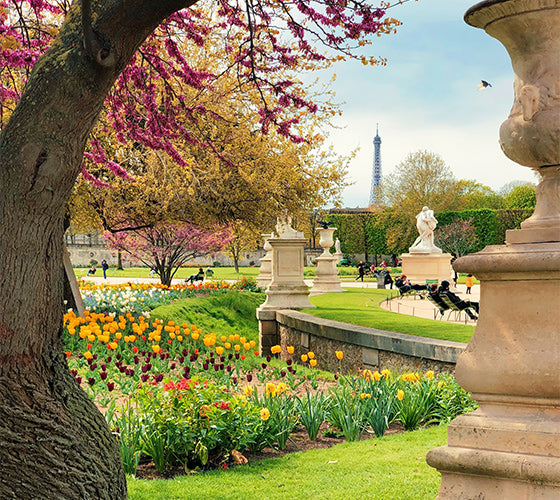The etymology of the word gardening refers to enclosure: it is from Middle English gardin, from Anglo-French gardin, jardin, of Germanic origin; akin to Old High German gard, gart, an enclosure or compound, as in Stuttgart. See Grad (Slavic settlement) for more complete etymology.The words yard, court, and Latin hortus (meaning "garden", hence horticulture and orchard), are cognates—all referring to an enclosed space.
Word forms: gardens, gardening, gardened
The term "garden" in British English refers to a small enclosed area of land, usually adjoining a building. This would be referred to as a yard in American English. A good garden is for architecture. "Mainly based on architecture, supplemented by gardens" In garden design, the style of the building must first be determined before the style of the garden can be determined, and then the architecture can be better reflected in the garden style, so that the building can be integrated into the environment, so that the environment can be better set off architecture.

ABOUT WORTH GARDEN
Nowadays, gardens are also the substantive embodiment of people's aesthetic taste, and the materialization of spirit. The construction of gardens is inseparable from nature. The architecture of the garden also hides the patriarchal power. The supreme ruler of the centralized whole wants to show the strength and dignity of the empire through architectural art to symbolize the supremacy and eternity of the kingship.
Based on historical background, cultural traditions, aesthetic ideas and philosophical theories, etc. It determines the different aesthetic thoughts of Western classical garden art. Western classical gardens emphasize artificial beauty and advocate changing nature with the laws and laws of beauty. Gardens can be divided into ancient, medieval, renaissance and other periods, and the style of gardens in each period is also different.
Western classical gardens have a symmetrical tidy pattern in the layout of the gardens, showing the way people transform and control nature, fully reflect the power of people. Horticulturists create beauty based on mathematical laws to the research and analysis of human nature, emphasize a strong visual experience. Usually its geometric pattern is piled up by the central axis, the straight boulevards, neat pools, gorgeous sculptures and fountains, and magnificent buildings. With reference to the rigorous and pure geometric symmetry of the layout structure, patterning and geometricalization of the plan layout. For example, the representative work of Le Notre-style gardens in France, the Versailles Garden marks the glorious period of French garden art. overall unity. Although influenced by Chinese classical gardens in the later period, natural-style landscape gardens began to appear in the UK, but on the whole, based on the aesthetic principles of geometric shapes, the plants and roads are still geometric. There is a clear axis and symmetry that runs through the entire garden. The building controls the axis, and it controls the garden, so building also controls garden, and Garden is subordinate to the building.


The garden is the link that leads us human beings to the natural environment, and the garden is a paradise where people and things live in harmony with each other. Regarding the beauty of nature, although the construction of Western gardens also highlights the poetic, the principle that Western traditional art follows is that "art imitates nature". It is the refinement and sublimation of mathematics in nature, and a rational cognition of nature. At the same time, in order to pursue perfection, garden creators should perfect natural beauty with corresponding concepts, and then elevate it to the level of artistic beauty.
Western classical gardens pursue artificial beauty. The garden requires a symmetrical, regular and rigorous layout, and the flowers and plants are trimmed squarely and the exquisite geometric patterns are highlighted. The balanced layout and the axis of symmetry can be seen in its strong rhythm. It reflects the overall beauty of contour, rhythm and form. Western gardens more embody the confrontation between human power and nature.
Western gardeners believe that the construction of gardens should be based on the patterns, rules and order in human thought, and to transform nature. In particular, the symmetrical layout of the central axis fully reflects the transforming power of human beings on nature, and the geometrically regular landscape created by humans occupies a major position. Trees, lawns, and buildings all reflect logic and integrity, pursuing perfection and harmony in such a form.
Although Western gardeners do not deny natural beauty, they only regard natural beauty as the source and material. They believe that this kind of beauty itself is not perfect, nor does it have an independent aesthetic meaning. Without the efforts of the artist, it will naturally not become a work of art, nor can it display its charm to the greatest extent. Therefore, natural beauty needs human transformation and processing in order to develop to perfection.

Gardens are also public places where flowers, trees, and other plants are grown for people to enjoy.
Western gardens seek to convey a sense of order and control, sometimes in contrast to the "chaotic" nature of nature. The garden creation is classified into the scientific scope of rigorous, precise and detailed. Garden is the embodiment of creativity in the process of human survival, production and lifestyle development. The symbolism of Chinese gardens, whether using rocks, pools, or selection of flowers and trees, gardens are an indispensable part of human civilization and the main carrier of human civilization and cultural heritage.










